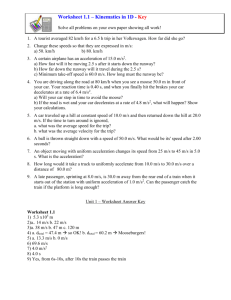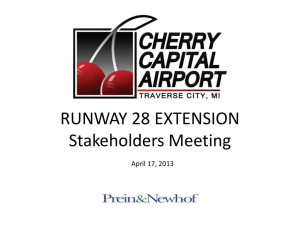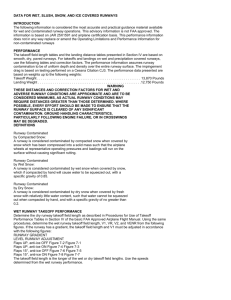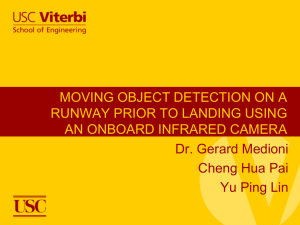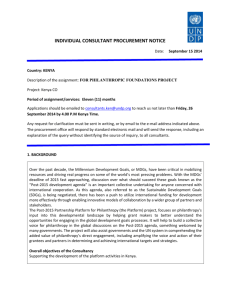Global Reporting Format For Runway Surface Condition
advertisement
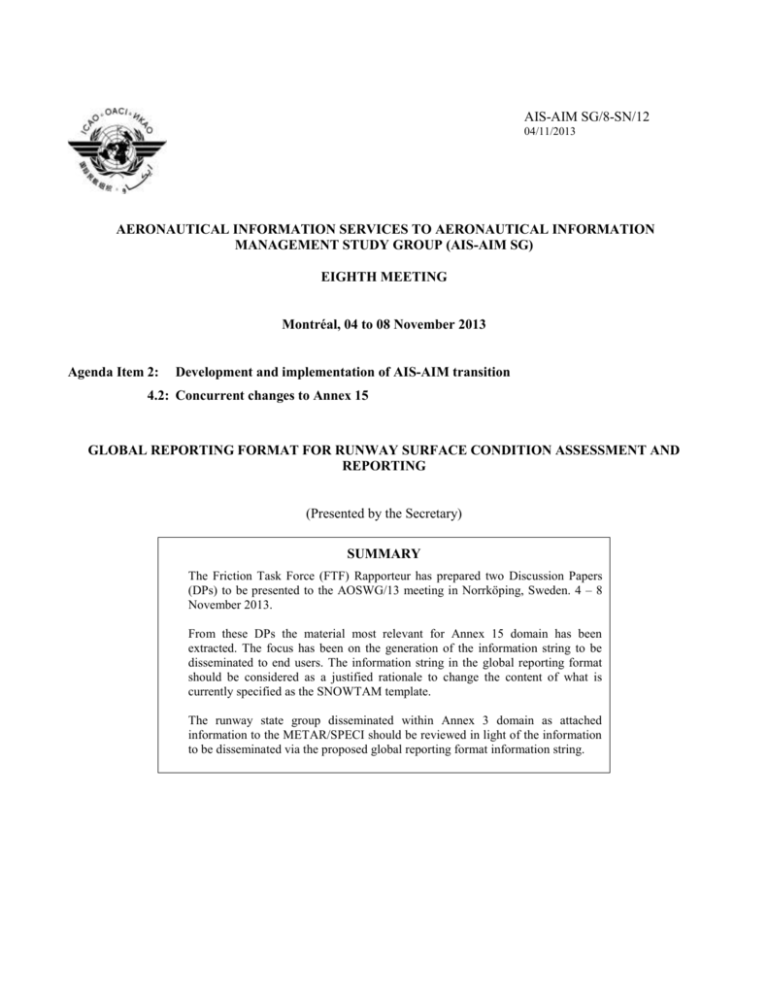
AIS-AIM SG/8-SN/12 04/11/2013 AERONAUTICAL INFORMATION SERVICES TO AERONAUTICAL INFORMATION MANAGEMENT STUDY GROUP (AIS-AIM SG) EIGHTH MEETING Montréal, 04 to 08 November 2013 Agenda Item 2: Development and implementation of AIS-AIM transition 4.2: Concurrent changes to Annex 15 GLOBAL REPORTING FORMAT FOR RUNWAY SURFACE CONDITION ASSESSMENT AND REPORTING (Presented by the Secretary) SUMMARY The Friction Task Force (FTF) Rapporteur has prepared two Discussion Papers (DPs) to be presented to the AOSWG/13 meeting in Norrköping, Sweden. 4 – 8 November 2013. From these DPs the material most relevant for Annex 15 domain has been extracted. The focus has been on the generation of the information string to be disseminated to end users. The information string in the global reporting format should be considered as a justified rationale to change the content of what is currently specified as the SNOWTAM template. The runway state group disseminated within Annex 3 domain as attached information to the METAR/SPECI should be reviewed in light of the information to be disseminated via the proposed global reporting format information string. 1. INTRODUCTION 1.1 The Friction Task Force (FTF), established under the aegis of the Aerodrome Operations and Services Working Group (AOSWG) of the Aerodromes Panel (AP), will be presenting its progress at AOSWG/13 (4 – 8 November 2013, Sweden) on the global reporting format. 1.2 The FTF completed its work on the proposed amendments to Annex 14, Vol I at the conclusion of FTF/12 (14 – 18 October, London). These are now presented to AOSWG/13 in DP/04, ATTACHMENT 1 – Proposed amendments to Annex 14 Aerodromes Volume 1 Aerodrome Design and Operations, draft 6th Edition, July 2013. 1.2.1 From DP/04: “The global reporting format has been detailed to such a degree that the format of the information string to be disseminated can be presented to Annex 11 and Annex 15 domain for the development of the procedures for dissemination and promulgation purposes, including those belonging to Annex 3 domain. The FTF has been advised that Annex 15 should be regarded as “work in process” and that a dedicated name should not be attached to the proposed global reporting format. However, FTF/12 felt strongly that a unique identification of the reporting format was of importance for operational purposes. The proposed global reporting format should be given such a unique identification through “the Annex 15 work in progress” and this unique identification should be used in all relevant documentation across all annex domains involved. It is recommended to develop harmonized training syllabus to be included in PANS and guidance documentation where PANS currently is not available (or not under development). Such training should include all personnel in the chain of information and involves following domains. Annex 1, Annex 3, Annex 11, Annex 14 and Annex 15. Target date for such syllabus to be developed within all involved Annex domains should be before third quarter of 2014.” 1.3 The FTF completed its work on the proposed amendments to PANS Aerodromes (Doc 9981) as far as it is relevant to the information string to be disseminated, at the conclusion of FTF/12. The format of the information and the order in which it shall be presented to end users are laid out. The global reporting format is intended to be the only reporting format for international aviation. The proposed amendments to PANS Aerodromes (Doc 9981) at the conclusion of FTF/12 are presented to AOSWG/13 in DP/04, ATTACHMENT 2 – Assessing the condition of the movement area and preparing the information for dissemination and promulgation to end users. 1.4 At the request of AOSWG/12, the FTF Rapporteur presented at EANPG/METG/23 WP/18 – The future of the runway state group in METAR SPECI. The outcome of this is presented to AOSWG/13 DP/07 – Report on FTF Phase 2 activities. 1.4.1 The following feedback was provided by the EANPG/METG/23 meeting. “3.3.4 The meeting also noted the recommendation from the ICAO Friction Task force to remove the runway state group from the METAR/SPECI when information provided by the proposed ADCON (Aerodrome Condition) with associated procedures was introduced; assuring that the end user at any given point of time was given the latest updated 14/11/13 2-2 runway state information available. ADCON would consider aeroplane performance as IFALPA informed the meeting that real time breaking measurements were provided. ADCON would also provide a time stamp of when the runway state information was issued. ADCON would also eliminate the possible conflict of information that currently exists if SNOWTAM and METAR/SPECI were issued at different times. 3.3.5 The meeting noted that no action was necessary at this time since an implementation on how ADCON would be generated and disseminated was not yet provided. The meeting also noted that the provisions of the ADCON information would be the responsibility of the aerodromes. 3.3.6 The meeting noted that when the ADCON matures, the Secretariat of the ICAO Friction Task Force should coordinate with the AMOFSG Secretariat in proposing the removal of the runway state group from the METAR/SPECI. Furthermore, the Secretariat would share this portion of the report with the AMOSFG Secretariat for common awareness. The Rapporteur of the ICAO Friction Task force was welcome to provide the METG/24 meeting an update on the development of ADCON. 1.4.2 AOSWG/13 DP/07 contains the following relevant to Annex 15 domain: ANC at the 10th meeting of its 192nd session on 12th March 2013, approved the ANC Working Group of the Whole for Strategic Review and Planning (ANC/SRP) job card AP001. AOSWG/12, Montreal, on the 1st and 2nd May, 2013 reviewed the job card and issued instructions to the FTF. This instruction was presented to FTF/11, Montreal, 3 to 6 June 2013 in FTF/11-DP/13. The instructions were: ……… Annex 15 Review Appendix 1 – Aerodrome information in AIP Review Appendix 2 – Consequence of ADCON Exercise care when introducing new acronyms ……… .. the FTF Rapporteur was informed (by the Secretary of AIS-AIM SG) that Annex 15 is currently undergoing a re-write and restructuring. Most of what we see as NOTAM format requirements will be relocated to a PANS-AIM to be applicable concurrent with the next major amendment to Annex 15. Thus is it important not to view Annex 15 as “stable” and therefore to modify its provisions but rather, “a work in progress”. The term ADCON for the global reporting format was not supported by the AIS-Secretariat. The main reason was that within the Annex 15 domain the use of specific names on NOTAMs was discontinued and that that the name ADCON for that reason could be very short-lived. FTF/12 took notice of this fact and discontinued use of the term ADCON. However, FTF/12 felt strongly that a unique identification of the reporting format was of importance for operational purposes. The proposed global reporting format should be given such a unique identification through “the Annex 15 work in progress”. Review of Appendix 1- Aerodrome information in AIP has not been finished yet but will be part of the task assigned to the PANS Aerodromes sub group to FTF. Review of Appendix 2 – SNOWTAM format is finished since the information string in the proposed global reporting format is developed and agreed upon at a consensus level at FTF/12. To take this to the next step the proposed global reporting format should be considered as a justified rationale to change the content of what is currently specified as the SNOWTAM template. This should be looked at by the Annex 15 domain. Regarding new acronyms, two has been identified by the FTF and are used in the proposed amendments to Annex 14, Vol I. they are: RWYCC - Runway Condition Code RCAM – Runway Condition Assessment Matrix These are two central terms used in definitions to establish the common and performancerelevant language between aerodrome, aeroplane manufacturer and aeroplane operator. These two terms should be included in PANS – ABC, ICAO Abbreviations and Codes, (doc 8400) as part of the global reporting format. 1.5 Regarding Annex 15, Appendix 1, AD section (Review of aerodrome information); the PANS Aerodromes SG of the FTF will have a meeting 19-20 November at Gatwick, UK. Appendix 1 will then be on the agenda. Focus will also be on the snow plan and review of the associated guidance material in the Airport Services Manual. 1.6 A draft timeline for the issuance of a State letter containing a complete package of proposed amendments to all related Annexes for the global reporting format is included in Attachment 3. 2. SUMMARY AND CONCLUSION 2.1 The FTF has completed vital parts of the global reporting format relevant to Annex 14 Vol I and PANS Aerodrome outlining the global reporting format and the information string to be disseminated. These parts are presented to AOSWG/13 for review and further actions. 2.2 Extracts of these proposed amendments are extracted as far as they have any bearing within the Annex 15 domain. 2.3 The information string in the global reporting format should be considered as a justified rationale to change the content of what is currently specified as the SNOWTAM template. 14/11/13 2-4 2.4 The FTF has identified an operational need to have an unique identification of the global reporting format. 3. 3.1 ACTION BY THE AIS-AIM SG The AIS-AIMSG is invited to: a) note the progress of the global reporting format; b) note the information string, arising from the global reporting format, which is proposed to replace what is currently specified as the SNOWTAM template; c) develop, based on the requirements in b), proposed amendment(s) to Annex 15 (and PANSAIMS), in collaboration with FTF; d) comment on the feasibility of the timelines in Attachment 3 for the issuance of an ICAO State letter comprising proposed amendments in, inter alia, Annex 15, for the implementation of a global reporting format. Attachment 1 : Extracts from AOSWG/13 DP/04 – Proposed amendment to Annex 14, Vol I. Attachment 2 : Extracts from AOSWG/13 DP/07 – Proposed material for PANS-Aerodromes Attachment 3 : Timeline for proposed amendments — END — ATTACHMENT 1 – Extracts from AOSWG/13 -DP/04 CHAPTER 2. AERODROME DATA …. 2.9 Condition of the movement area and related facilities 2.9.1 Information on the condition of the movement area and the operational status of related facilities shall be provided to the appropriate aeronautical information services units, and similar information of operational significance to the air traffic services units, to enable those units to provide the necessary information to arriving and departing aircraft. The information shall be kept up to date and changes in conditions shall be reported timely and without delay. Note .— Nature, format and conditions of the information to be provided are specified in Annex 15 and PANS-ATM (Doc 4444). 2.9.2 The condition of the movement area and the operational status of related facilities shall be monitored, and reports on matters of operational significance affecting aircraft and aerodrome operations shall be provided in order to take appropriate action, particularly in respect of the following: a) construction or maintenance work; b) rough or broken surfaces on a runway, a taxiway or an apron; c) water, snow, slush, ice, or frost on a runway, a taxiway or an apron; d) water on a runway, a taxiway or an apron; d) anti-icing or de-icing liquid chemicals or other contaminants on a runway, taxiway or apron; e) snow banks or drifts adjacent to a runway, a taxiway or an apron; f) anti-icing or de-icing liquid chemicals or other contaminants on a runway, taxiway or apron; gf) other temporary hazards, including parked aircraft; hg) failure or irregular operation of part or all of the aerodrome visual aids; and ih) failure of the normal or secondary power supply. Note 1.— Other contaminants may include mud, dust, sand, volcanic ash, oil and rubber. Annex 6, Part I, Attachment C provides guidance on the description of runway surface conditions. Additional information is included in the Airport Services Manual (Doc 9137), Part 2.PANS-Aerodromes (Doc 9981). 14/11/13 2-6 Rationale: Water can be listed together with snow, slush, ice or frost and old item d can be deleted. The relevant parts of the additional guidance in Airport Services Manual (Doc 9137), part 2 is proposed rewritten and moved to PANS Aerodromes (Doc 9981). Note 2.— Annex 6, (location to be decided within Annex 6 domain) provides guidance on the description and resolution of runway surface conditions. in 2.9.2 c), d), e) and f).These operational requirements stem from the Annex 6 and Annex 8 domain with the purpose to achieve the desired level of safety for the aeroplane operations. Rationale: The reference to Annex 6 needs to be updated pending the outcome from Annex 6/8 subgroup discussions. Note 3.— Origin of data and assessment process resulting in information stems from Annex 14 domain and the procedures that are prescribed in PANS-Aerodrome. These procedures are intended to fulfil the requirements to achieve the desired level of safety for aeroplane operations prescribed by Annex 6 and Annex 8 and to provide the information fulfilling the syntax requirements for dissemination within Annex 15 and Annex 11 domain. Rationale: The current text – Nature, format and conditions of the information to be provided – appear confusing when only related to Annex 15 and PANS-ATM (Doc 4444). Annex 15 and PANSATM does give the syntax and format for dissemination, but do not provide or contain the operational requirements (Annex 6 and Annex 8) dictating the data collection and origin of the information (Annex 14) to be disseminated. There seems to be confusion related to the understanding of how information are provided and disseminated, and the purpose of this dissemination. The Notes proposed bring more clarity to this issue. Note 2. — Particular attention would have to be given to the simultaneous presence of snow, slush, ice, wet ice, snow on ice with anti-icing or de-icing liquid chemicals. Note 3. — See 2.9.11 for a list of winter contaminants to be reported. Rationale: Note 2 is proposed moved/incorporated into PANS Aerodromes. Note 3 is there as a consequence of Note 2 and points to another paragraph. When Note 2 is moved Note 3 can be removed. Note 1.— The intent of these specifications is to satisfy the SNOWTAM and NOTAM promulgation requirements contained in Annex 15. Rationale: This information is provided in the proposed notes 2 and 3 to para 2.9.2. There should be no need to duplicate this information even tho the reporting format is not specifically named in note 2 and 3 to paragraph 2.9.2. Note 2.— Runway surface condition sensors may be used to detect and continuously display current or predicted information on surface conditions such as the presence of moisture, or imminent formation of ice on pavements. 2.9.8 Whenever an operational runway is contaminated by snow, slush, ice or frost, the runway surface condition shall be assessed and reported by using the procedures described in PANS-Aerodromes (Doc 9981). Rationale: Proposed to review in light of the global reporting format all relevant guidance material and move what is kept to PANS Aerodromes (Doc 9981). This will be guidance material supporting the global reporting format. 2.13.4 The aerodrome services responsible for the provision of raw aeronautical information/data to the aeronautical information services shall do that while taking into account accuracy and integrity requirements for aeronautical data as specified in Appendix 5 to this Annex. Note 1.— Specifications for the issue of NOTAM and SNOWTAM (Identification of the global reporting format tbd within Annex 15 domain (Work in process)) are contained in Annex 15, Chapter 5 and Appendices 6 and 2, respectively. 14/11/13 2-8 -2- AIS-AIMSG/8-SN/12 ATTACHMENT 2 – Extracts from AOSWG/13 - DP/07 FROM AOSWG/13 - DP/04, ATTACHMENT 1 - Assessing the condition of the movement area and preparing the information for dissemination and promulgation to end users. 1 OPERATIONAL PRACTICES 1.1. The information to be reported shall be compliant with the global reporting format which have two sections; a) aeroplane performance calculation section b) situational awareness section 2.1. The information to be reported shall contain information in an information string with information in following order using only AIS compatible characters. a) Aeroplane performance calculation section Aerodrome location indicator Time and date of assessment Lower runway designation number Runway Condition Code for each runway third Per cent contaminant coverage for each runway third Depth of loose contaminant for each third Condition description for each third Cleared runway width if less than published width Cleared runway length if less than published length of the runway. b) Situational awareness section 14/11/13 Snowbanks on the runway Snowbanks adjacent to the runway Drifting snow on the runway Sanding treatment Chemical treatment Taxiway conditions Apron conditions 2-- 2 - -3- AIS-AIMSG/7-SN/12 State approved and published use of measured friction coefficient. Plain language remarks 3.1. The global reporting format – Aeroplane performance calculation section Aerodrome location indicator shall be the four letters ICAO Location Indicator. Format: XXXX Example: ENCN Date and time of assessment shall be the date and time (UTC) when the assessment was performed by the trained and competent assessment personnel. Format: YYYYMMDDhhmm Example: 201309111357 Lower runway designation number shall be the two or three characters identifying the runway for which the assessment is valid for. Regardless of observation direction during assessment or landing or take off direction of on-going traffic, the lower runway designation number shall be reported. Format: NNX Example: 09L Runway Condition Code for each runway third shall be the one digit number identifying the Runway condition Code assessed for each runway third. The runway codes shall be reported in a five character group separated by a “/” for each third. The direction for listing the runway thirds shall always be in the direction as seen from the lower designation number. Figure 1 - Reporting of Runway Condition Code for runway thirds Format: Example: N/N/N 3/5/2 -4- AIS-AIMSG/8-SN/12 How to derive an assessed runway condition code follows from a predefined set of procedures as described in paragraph 4. Per cent contaminant coverage for each runway third shall be the three digit number identifying the percentage coverage. The percentages shall be reported in a nine character group separated by a “/” for each runway third. The direction for listing the runway thirds shall always be in the direction as seen from the lower designation number. The assessment is based upon an even distribution within the runway thirds. Percentages as described in Table 1 ― Percentage of coverage for contaminants ― shall be used: Table 1 – Percentage of coverage for contaminants Assessed percent 10– 25 26 – 50 51 – 75 76 – 100 Reported percent 25 50 75 100 Format: NN/NN/NN Example: 25/50/50 With uneven distribution of the contaminants additional information shall be given in the plain language remark item of the Situational awareness section of global reporting format. When possible a standardised text should be used. Example: (Standardised text tbd) Depth of loose contaminant shall be the one or two digit number representing the assessed depth of the contaminant for each runway third. The depth shall be reported in a six to nine character group separated by a “/” for each runway third. The direction for listing the runway thirds shall always be in the direction as seen from the lower designation number. The assessment is based upon an even distribution within the runway thirds as assessed by a trained and competent person. STANDING WATER DRY SNOW WET SNOW SLUSH Format: Examples: 14/11/13 Reporting in steps of (mm) 3, 6 and 12,… 6, 12, 24, 48,… 6, 12, 24,… 6, 12,… NN/NN/NN 3/3/6 3/6/12 12/12/12 With uneven distribution of the contaminants additional information should be given in the plain language remark item of the Situational awareness section of global reporting format. When possible a standardised text should be used. Example: (Standardised text tbd) Condition type shall be reported in capital letters as written from approved list identified in Annex 14 paragraph 2.9.5. This list is harmonized with standards and recommended practices within Annex 6 ― Operation of Aircraft, Annex 8 ― Airworthiness of Aircraft, Annex 11 ― Air Traffic Services, and Annex 15 ― Aeronautical Information Services domain. The condition type shall be reported in an up to 100 character group separated by a “/” for each runway third. The direction for listing the runway thirds shall always be in the direction as seen from the lower designation number. 2-- 4 - -5- DRY WET ICE WATER ON TOP OF COMPACTED SNOW DRY SNOW DRY SNOW ON TOP OF ICE WET SNOW ON TOP OF ICE ICE SLUSH STANDING WATER COMPACTED WET DRY SNOW ON TOP OF WET SNOW ON TOP OF WET FROST CHEMICALLY SANDED AIS-AIMSG/7-SN/12 COMPACTED COMPACTED SNOW SNOW SNOW SNOW TREATED Format: XXXX.../XXXXX.../XXXX … Example: DRY SNOW ON TOP OF COMPACTED SNOW/WET SNOW ON TOP OF COMPACTED SNOW/WATER ON TOP OF COMPACTED SNOW Cleared runway width shall be the two digit number representing the width of cleared runway in metres if less than published width. Format: NN Example: 30 If the cleared runway width is not symmetrical along the centre line additional information shall be given in the plain language remark item of the Situational awareness section. When possible a standardised text should be used. Example: (Standardised text tbd) Cleared runway length if less than the published runway length shall be the three or four digit number representing the length of cleared runway in metres. Format: NNNN Example: 1800 When full length is not cleared, additional information should be provided about the condition of the uncleared part using descriptions from item g above in the plain language remark item of the Situational awareness section . When possible a standardised text should be used. Example: (Standardised text tbd) Plain language remarks Additional information (location of contaminants, etc). (Menu of standardised texts). AIS-AIMSG/8-SN/12 3.2 14/11/13 -6- The global reporting format - Situational awareness section: Drifting snow on the runway Example: Sanding treatment DRIFTING SNOW Example: Chemical treatment RWY SANDED Example: RWY CHEMICALLY TREATED Snowbanks on the runway or taxiway Left or Right distance in metres from centreline, L. R, LR XX Max height in cm XX Example: RWY SNOWBANK LR 22 FROM CL HEIGHT 20 Snowbanks adjacent to the runway penetrating level/profile set in the local snow plan. Example: Taxiway conditions ADJACENT SNOWBANKS Example: Apron conditions TWY POOR Example: APRON POOR State approved and published use of measured friction coefficient. Example: [State set format and associated procedures] Plain language remarks using only allowable characters in capital letters. Where possible standardised text should be developed. POOR POOR 2-- 6 - -7- AIS-AIMSG/7-SN/12 3.3 Information string Example of a complete information string to be handed over for dissemination: [Aeroplane performance calculation section] ENCN 201309111357 09L 3/3/2 25/50/50 3/6/12 DRY SNOW ON TOP OF COMPACTED SNOW/WET SNOW ON TOP OF COMPACTED SNOW/WATER ON TOP OF COMPACTED SNOW 30 1800 [Situational awareness section] DRIFTING SNOW, RWY SANDED, RWY CHEMICALLY TREATED, RWY SNOWBANK LR 22 FROM CL HEIGHT 20, ADJACENT SNOWBANKS, TWY POOR, APRON POOR [Remarks –additional information(location of contaminants,(Menu of standardised texts, etc] -8- AIS-AIMSG/8-SN/12 ATTACHMENT 3 – TIMELINES 2014 Q1 Q2 AP 3 (4.2014) Q3 All proposals in place Q4 ANC preliminary review SARPS in Annexes 1, 3, 6, 8, 11, 14, 15 PANS procedures 2015 Q1 State letter Q2 3 months for responses Q3 Secretary analysis Q4 ANC final review Development of - Guidance - Training 2016 Q1 Roll-out? SARPS adopted by the Council Q2 Q3 Q4 2017 2018 14/11/13 2-- 8 -


